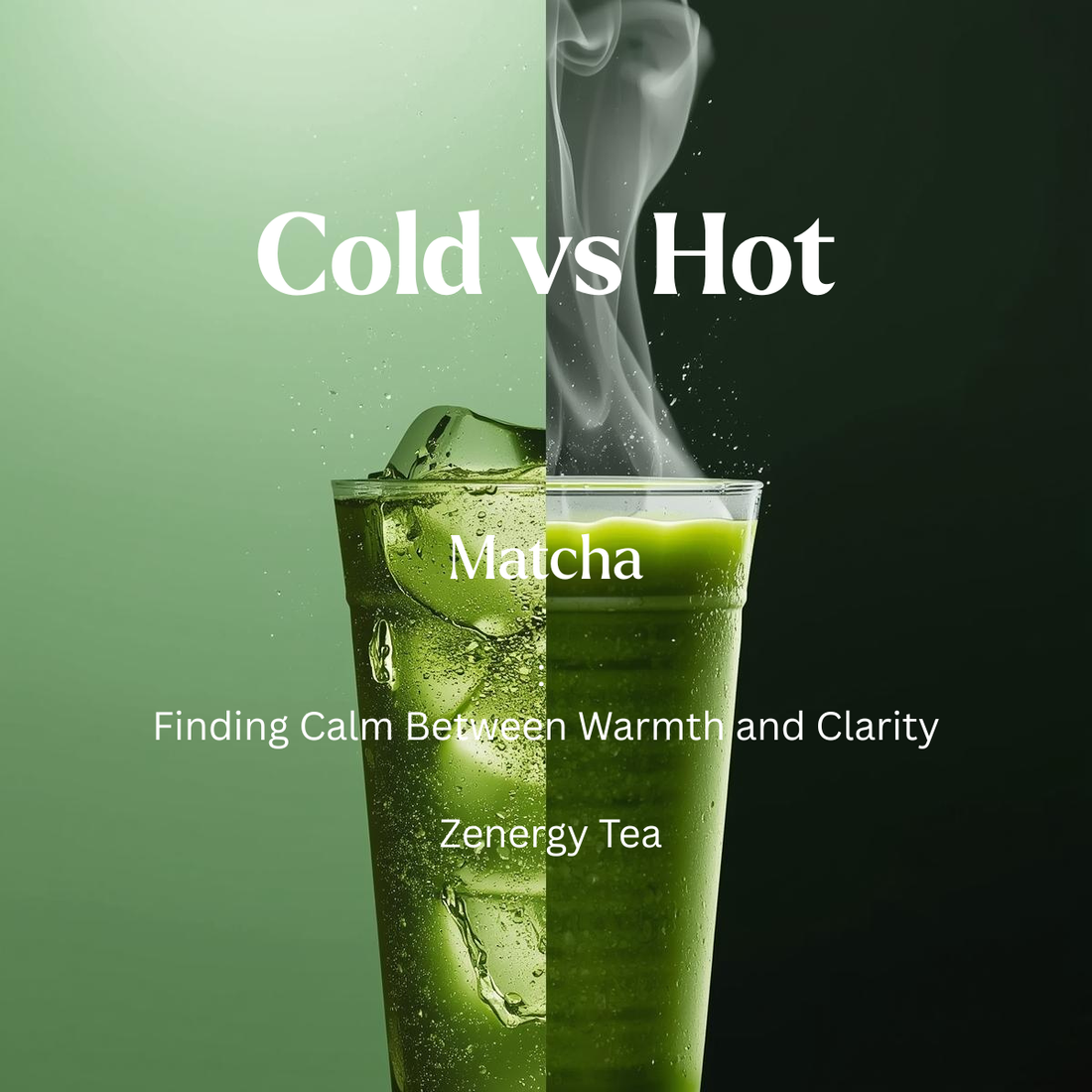
Cold vs Hot Matcha: Finding Calm Between Warmth and Clarity | Zenergy Tea
Share
Quick Summary
Temperature changes everything about matcha—taste, aroma, and emotion.
Cold matcha is smooth and light; hot matcha is deep and aromatic.
The best flavor balance comes from room-temperature whisking (18–25 °C / 64–77 °F).
Cold reduces bitterness but hides aroma; heat awakens scent but adds edge.
Calm often lives between the two.
Mornings of Fog, Afternoons of Dust
In Napa Valley, autumn begins in fog.
By noon, the mist dissolves, and the hills turn dry and sharp again.
The mornings are soft and silver; the afternoons hum with heat.
It’s a season that wakes cool and sleeps parched.
Some mornings I crave the steam of a hot bowl; other afternoons, I reach for the quiet chill of a cold one.
They both start from the same leaf—but the water decides the story.
Cold feels right for the weather, but every time I shake it, something disappears.
It’s sweet, yes. Smooth, yes. But the scent that used to rise like quiet smoke from the bowl—it’s gone.
Cold brew matcha lowers bitterness, but it also lowers aroma.
And somehow, that feels like the season itself—soft, beautiful, and a little out of reach.

What Happens When You Make Matcha Cold
When matcha meets cold water, it stops speaking so loudly.
The green stays bright, but the fragrance hides.
At low temperatures, the volatile compounds that create matcha’s scent—the aldehydes and pyrazines—barely move.
They need warmth to lift, to breathe.
Catechins, the molecules that give bitterness, dissolve slowly in cold water.
That’s why cold brew matcha tastes rounder, gentler, easier to drink.
But in that ease, something gets locked away.
The thin sweetness of L-theanine is still there, yet it floats without direction, like a thought that forgot where it began.
So the drink feels perfect for a fog-washed morning—and slightly incomplete by afternoon.
But what about the warmth?
The same leaf behaves differently when it meets heat.
What Heat Brings to Matcha
When matcha meets hot water—around 70–80 °C (158–176 °F)—aroma unfolds instantly.
The steam carries grassy sweetness and roasted notes that cold water hides.
L-theanine and catechins dissolve together, creating both depth and gentle bitterness.
It feels fuller, more expressive, almost like the leaf remembering its origin in the sun.
The first sip of hot matcha fills the air, not just the mouth.
It’s alive, fragrant, slightly wild—and comforting in a way cold never is.
The warmth moves outward; the calm moves inward.

Cold Brew Matcha vs Hot Matcha — A Quiet Comparison
Cold Brew Matcha vs Hot Matcha
| Element | Cold Brew Matcha | Hot Matcha |
|---|---|---|
| Aroma | Subtle, hidden | Bold, rising with steam |
| Taste | Smooth, sweet | Deep, slightly bitter |
| Texture | Light, refreshing | Creamy, full-bodied |
| Feeling | Cooling clarity | Comforting warmth |
| Best Time | Dry afternoons | Misty mornings |
Maybe that’s why both belong to autumn — the fog for cold, the warmth for clarity.

Useful Facts: How Temperature Shapes Taste
Optimal Whisking Range:
-
18–25 °C (64–77 °F) is ideal for whisking matcha.
At this range:Aroma compounds gently vaporize, allowing fragrance to rise.
L-theanine and amino acids dissolve, creating sweetness and umami.
Catechins stay limited, keeping bitterness low.
Below 15 °C (59 °F):
Aroma compounds stay trapped; flavor feels muted.
Above 30 °C (86 °F):
Catechins dissolve faster, increasing bitterness and dulling color.
Traditional Hot Matcha Range:
Most tea masters use 75–80 °C (167–176 °F) for balance—where aroma blooms but harshness remains gentle.
Balanced Iced Matcha Method:
Add 1 g matcha to 60–70 ml (≈ 2 oz) room-temperature water (≈ 21 °C / 70 °F).
Whisk 15–20 seconds until fine foam appears and aroma lifts.
Add ice or cold water to chill and serve immediately.
This “two-temperature method” preserves the sweetness of warmth and the clarity of cold.
The Small Ritual
y routine has become simple:
one gram of matcha, seventy milliliters of room-temperature water, a gentle whisk until it shines.
Then I drop two ice cubes and listen to the sound they make—small, perfect, final.
The foam settles into a thin film. The first sip is sweet, the second cleaner, the third almost silent.
I can taste the faint ocean under the leaf, a softness that fades too quickly.
Sometimes I miss the warmth that used to lift the scent.
Sometimes I don’t.
What the Tongue Learns
Taste is not just chemistry; it’s context.
In winter, the same cup would feel empty.
In summer, it would feel right.
Now, in autumn, it feels like standing in the middle—between craving and letting go.
When I drink hot matcha, the air fills with steam and story.
When I drink cold matcha, everything turns inward.
It’s not better or worse—it’s just quieter.
The bitterness hides; the aroma rests.
Maybe the tea isn’t weaker. Maybe it’s just waiting.

No Need to Decide
Sometimes we try to fix flavor—to control it, repeat it, own it.
But tea doesn’t work like that.
The same leaf tastes different on different days, under different skies.
So does water, and mood, and hand movement.
Maybe the question isn’t whether cold or hot matcha is better,
but what kind of calm we need that day.
Some mornings begin in fog; some afternoons end in dust.
The cup stays the same. Only the air changes.

Aileen Gong is a food creator, sommelier, and graduate of the School of the Art Institute of Chicago.
She shares quiet, beautiful recipes that celebrate simple rituals and mindful flavors.
She grows blueberries in pots, hand-whisks her matcha, and believes every drink can be a small moment of peace.
1. Can you cold brew matcha?
Yes. Cold water lowers bitterness but mutes aroma. Whisk with room-temperature water first, then add ice for balance.
2. What temperature is best for matcha?
Room-temperature whisking at 18–25 °C (64–77 °F) keeps flavor round and aroma active.
3. How hot should water be for traditional matcha?
Around 75–80 °C (167–176 °F)—warm enough for fragrance, cool enough to stay sweet.
4. Is hot matcha healthier than cold matcha?
They’re similar nutritionally, but heat releases more catechins and caffeine, while cold keeps theanine and sweetness.
5. Which tastes better—cold or hot matcha?
Neither wins. Cold brings clarity; hot brings depth. The best choice depends on your moment.
References
Journal of Food Science. “Effect of Temperature on Catechin Extraction in Green Tea.” Wiley Online Library, 2020.
https://ift.onlinelibrary.wiley.com/journal/17503841
